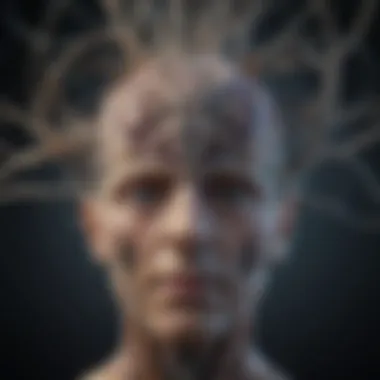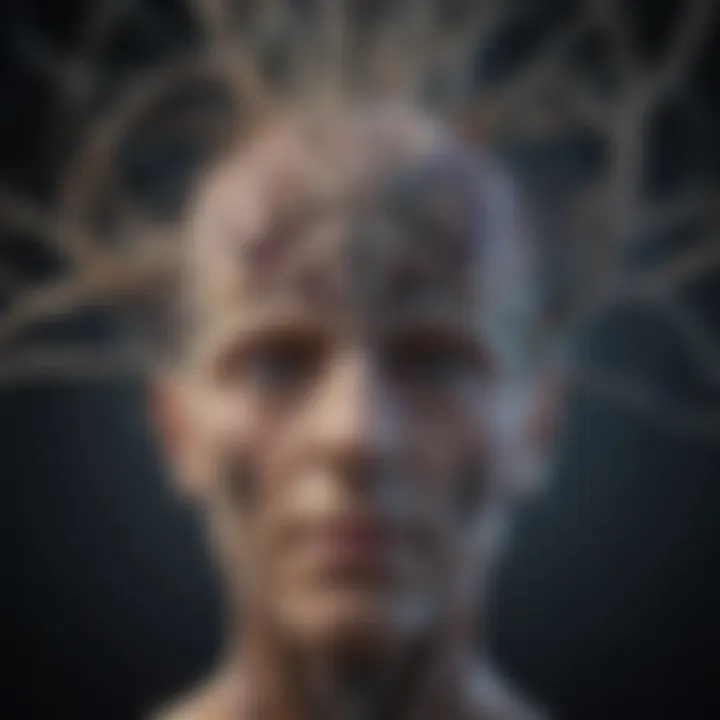Auditory Hallucinations in Schizophrenia: A Deep Dive


Intro
Auditory hallucinations represent a notable symptomatology within the realm of schizophrenia. Many individuals afflicted by this condition experience internal voices that seem very real, often influencing their thoughts and behaviors. Understanding these auditory hallucinations is crucial for mental health professionals and researchers alike, as it sheds light on the intersection of neurology and psychological phenomena.
This article serves to unravel intricate aspects of auditory hallucinations as experienced in schizophrenia. It encompasses recent findings and provides insight into how these manifestations affect daily life and functionality. By synthesizing various research studies and clinical observations, we aim to provide a well-rounded view of the subject.
Research Overview
Summary of Key Findings
Auditory hallucinations in schizophrenia are prevalent among a significant portion of the population affected by this disorder. Research indicates that approximately 50% of individuals with schizophrenia experience these auditory disturbances at some point during their illness. The experiences may vary widely in intensity and meaningfulness. Some individuals report hearing commands or critical voices, while others experience more benign auditory phenomena.
Neurological studies have identified distinct brain activity patterns associated with these hallucinations. Areas such as the temporal cortex, responsible for auditory processing, show heightened activity during hallucinations. Psychological assessments reveal that these phenomena can potentially be linked with a person’s past trauma and current stressors. The interplay between neurological and psychological factors is vital in constructing a comprehensive understanding of these auditory experiences.
Importance of the Research
Understanding the dynamics of auditory hallucinations is essential not only for improving treatment strategies but also for fostering empathy and support within communities. The insight gathered from this research can inform clinical practice, leading to improved therapeutic approaches tailored for individuals experiencing these challenges.
Methodology
Study Design
Research in this area often employs a mixed-methods approach, combining quantitative data from clinical assessments with qualitative narratives from individuals experiencing auditory hallucinations. This dual-phase design allows for a comprehensive understanding of the subjective nature of these symptoms while grounding the findings in empirical data.
Data Collection Techniques
Data collection methods vary widely and may include:
- Structured interviews with individuals diagnosed with schizophrenia
- Neuroimaging techniques such as fMRI to observe brain activity
- Surveys aimed at gathering self-reported experiences of auditory hallucinations
Such diverse methodologies are integral to capturing the complexity of auditory hallucinations in schizophrenia. Further examination of these techniques will contribute to greater awareness and will enhance the treatment landscape.
Understanding Schizophrenia
Understanding schizophrenia is vital for comprehending the broader topic of auditory hallucinations. This mental disorder can affect cognition, emotion, and behavior, shaping how individuals experience reality. By exploring the fundamental aspects of schizophrenia, one can grasp the nuances that contribute to the manifestation of auditory hallucinations.
Specifically, a thorough understanding of schizophrenia sets the stage for delving into its various symptoms and treatments. It illuminates the interplay between biological, psychological, and environmental factors that lead to auditory experiences in those diagnosed with the disorder. This knowledge is crucial for students, researchers, educators, and professionals who seek to engage with the complexities surrounding mental health.
Definition and Overview
Schizophrenia is a chronic mental disorder characterized by disruptions in thought processes, perceptions, emotional responsiveness, and social interactions. Individuals with this condition may experience a range of symptoms, including delusions, hallucinations, disorganized thinking, and impaired functioning. The onset typically occurs in late adolescence or early adulthood, though it can emerge at different stages of life.
Evolving research continues to reshape the understanding of its causes, which include genetic, neurobiological, and environmental components. The condition’s presentation can vary widely, leading to diverse experiences among individuals.
Historical Context
The historical perception of schizophrenia has undergone significant transformation over time. Early understandings often attributed the symptoms to spiritual or supernatural forces. In the 19th century, Emil Kraepelin introduced the term 'hebephrenia' referring to a type of schizophrenia. This marked a shift towards a more medical model.
As research progressed throughout the 20th century, schizophrenia began to be framed within the context of psychological and biological theories. With advancements in neuroscience, the spotlight has shifted towards understanding brain function and its role in the disorder.
Epidemiology
Epidemiology plays an essential role in the study of schizophrenia, offering insight into its prevalence and impact on societies.
Global Prevalence
Global prevalence of schizophrenia is estimated to be around 1%, showing a relatively consistent rate across different cultures and regions. This statistic highlights the disorder's universal scope and the necessity of tailored treatment approaches worldwide. A key characteristic of this prevalence is its independent nature from socio-economic factors, meaning it affects diverse populations equitably.
The unique feature of this global presence allows for comparative studies across regions, which can enhance understanding of cultural influences on symptoms and treatment outcomes. However, challenges exist, such as underreporting in certain areas, which may skew the perceived magnitude of the issue.
Demographic Factors
Demographic factors are crucial in understanding how schizophrenia manifests across various populations. Age, gender, and socio-economic status can influence the onset and severity of symptoms. Studies show that males tend to experience an earlier onset of schizophrenia compared to females.


What is notable about demographic influences is their ability to affect not only the prevalence but also the cultural response to treatment and stigma associated with the disorder. Understanding these factors helps shape effective intervention programs and supports that cater to the specific needs of different demographic groups. Thus, incorporating demographic elements allows for a more nuanced understanding of how schizophrenia operates within society.
Auditory Hallucinations Explained
Auditory hallucinations represent a critical aspect of schizophrenia. Their examination uncovers the intersection of neurological disorders and subjective experience. Understanding these phenomena provides insight into the cognitive processes and emotional experiences of those affected. This section elucidates the characteristics, types, and implications of auditory hallucinations, helping to frame their relevance in clinical settings. Knowledge of these aspects not only aids in diagnosis and treatment but also enhances empathetic engagement with individuals experiencing these disturbing sensations.
Definition of Auditory Hallucinations
Auditory hallucinations are perceptions of sounds that an individual hears without external stimuli. These sounds often manifest as voices or noises that can be intrusive and distressing. They occur frequently in schizophrenia, significantly impacting daily functioning. Understanding this definition clarifies the lived experiences of those with the condition.
Types of Auditory Hallucinations
There are various types of auditory hallucinations, each with distinct characteristics. Recognizing these types contributes to a more comprehensive understanding of how they present in schizophrenia.
Command Hallucinations
Command hallucinations involve the auditory perception of voices directing an individual to perform specific actions. This type is often linked to heightened risk factors, including self-harm or harm to others. The key characteristic of command hallucinations is their often authoritative or demanding nature. This aspect is critical to discuss in this article because it poses significant ethical and safety considerations in treatment. The unique feature of command hallucinations is their potential to compel individuals towards actions they may not otherwise consider. This raises concerns regarding autonomy and the therapeutic approaches needed to navigate such experiences effectively.
Conversational Hallucinations
Conversational hallucinations occur when individuals hear voices engaging in dialogue. These voices may represent familiar individuals or entirely unknown personas. The key characteristic here is their interactive quality, which can blur the line between reality and hallucination. This makes conversational hallucinations notable for their potential impact on social perceptions and relationships. This article highlights conversational hallucinations because they illustrate the complexity of communication deficits in individuals with schizophrenia. The unique feature of this type is that it can elicit emotional responses, sometimes fostering feelings of companionship or distress, altering the dynamics of how individuals perceive reality.
Non-Verbal Sounds
Non-verbal sounds encompass auditory experiences that do not involve speech, such as music, whispers, or noises. The key characteristic of non-verbal sounds is their abstract nature, lacking coherent structures. This type is significant in the discussion on auditory hallucinations because it reveals other dimensions of perceptual disturbances. Non-verbal sounds can evoke strong emotional responses, impacting mood and behavior profoundly. Their unique feature lies in their pervasive presence, often described as background noise, and their subtle yet impactful role in the challenges experienced during everyday life.
Neuroscience of Auditory Hallucinations
Understanding the neuroscience behind auditory hallucinations is crucial for comprehending their complex nature. These hallucinations significantly contribute to the challenges faced by individuals with schizophrenia. The integration of neuroscience sheds light on the biological mechanisms involved, helping clarify how these auditory experiences manifest. Gaining insights into this area enhances both research and clinical practice, promoting more effective approaches to treatment and support.
Brain Regions Involved
Temporal Lobes
The temporal lobes play a significant role in processing auditory information. They are key regions where the perception of sounds occurs. This makes them important when discussing auditory hallucinations. In schizophrenia, altered activity in the temporal lobes is often associated with the experience of hearing voices or sounds that aren't present in the environment. This aspect makes them a beneficial choice for this article because it connects directly to the experience of auditory hallucinations.
A unique feature of the temporal lobes is their involvement in language comprehension. As hallucinations often have a verbal component, understanding how these lobes function can reveal their contribution to specific auditory experiences. However, variations in how these lobes operate might create challenges in treatment approaches, possibly leading to diverse responses among patients.
Frontal Lobes
The frontal lobes are crucial for executive functions, including decision-making and impulse control. Their role in schizophrenia is multifaceted, as they also help regulate emotions and social behavior. This is particularly relevant to auditory hallucinations, which can affect how individuals interact socially. Their involvement makes the frontal lobes an essential area of focus in this article, as they highlight the cognitive aspects related to the disorder.
A key characteristic of the frontal lobes is their ability to filter information from the environment. This filtering process can be impaired in individuals experiencing hallucinations, leading to difficulties in distinguishing reality from auditory inputs. Understanding this unique feature aids in grasping how disturbances in the frontal lobes may contribute to the severity of symptoms in schizophrenia.
Auditory Cortex
The auditory cortex is responsible for processing sound signals. Its unique role makes it a central element in understanding auditory hallucinations. Abnormal activity in the auditory cortex may correlate with the experience of hearing non-existent voices and sounds, thereby linking it vital to this article's discussion.
The auditory cortex’s flexibility in responding to different sound frequencies can also play a part in how individuals hear these hallucinations. However, disruptions in its functioning can result in a range of auditory experiences, identifying potential targets for therapeutic intervention. This duality of function highlights both the advantages of focusing on the auditory cortex and the challenges in treatment due to variability in individual experiences.
Neurotransmitters and Pathways
Dopaminergic Pathway
The dopaminergic pathway is intricately linked to various psychiatric conditions, most notably schizophrenia. Dopamine's role in reward processing and motivation makes it crucial for understanding the disorder's symptoms. The overactivity of this pathway is often associated with positive symptoms, such as auditory hallucinations.
A key characteristic of the dopaminergic pathway is its influence on perception and cognition. Its significance in this article lies in highlighting how dopamine dysregulation can explain the mechanisms behind hallucinations. An advantage of focusing on this pathway is that it provides a clear target for pharmacological interventions, such as antipsychotics that regulate dopamine levels.
However, an unique aspect is that not all patients respond uniformly to treatments targeting this pathway. This variability can lead to different outcomes in managing auditory hallucinations, emphasizing a need for personalized treatment strategies.
Glutamate and GABA
Glutamate and GABA are essential neurotransmitters that regulate excitatory and inhibitory signals in the brain. Their balance is crucial for effective brain functioning. In the context of schizophrenia, disruptions in this balance can contribute to the development of auditory hallucinations.
A central characteristic of glutamate is its role in synaptic plasticity, which is vital for learning and memory. In contrast, GABA serves to inhibit excessive neuronal activity. Recognizing the interplay between these two neurotransmitters provides a comprehensive understanding of auditory hallucinations.


The unique feature of investigating glutamate and GABA in this article lies in the potential for novel treatment approaches. Targeting this neurotransmitter system could lead to innovative therapies that go beyond traditional antipsychotics. However, balancing their effects presents challenges, highlighting the complexity in managing schizophrenia and its symptoms.
Psychological Perspectives
Psychological perspectives provide essential insights into how individuals with schizophrenia experience auditory hallucinations. Understanding these perspectives can illuminate the underlying cognitive processes, life experiences, and environmental factors influencing these symptoms. This article segment focuses on two main areas: cognitive models of auditory hallucinations and the influence of trauma.
Cognitive Models of Auditory Hallucinations
Cognitive models offer frameworks for understanding why and how auditory hallucinations occur. These models suggest that hallucinations arise from cognitive misinterpretations of sensory input. For instance, when a person hears a sound, their brain might incorrectly attribute that sound to an external source rather than recognizing it as a product of their mind. This misattribution can amplify feelings of distress and confusion.
Key cognitive processes involved include:
- Perceptual Disturbance: An individual might misinterpret their inner voice as a real, external voice. This leads to increased anxiety and a sense of loss of control.
- Negative Self-Schema: Those who frequently experience auditory hallucinations may have a negative perception of themselves, making the hallucinations more distressing.
- Attention Bias: People with schizophrenia often show an inclination to focus on threatening stimuli, which can trigger or worsen hallucinations.
These models emphasize the role of cognitive functioning in managing symptoms, indicating potential avenues for therapeutic interventions.
Influence of Trauma
The relationship between trauma and auditory hallucinations is critical, particularly in understanding the severity and frequency of these experiences. Trauma can take various forms, including childhood abuse, neglect, and exposure to violence. Research shows that individuals with such experiences often exhibit heightened sensitivity to stress, leading to greater vulnerability to hallucinations.
- Trauma History: Many individuals with schizophrenia report a significant history of traumatic events. These experiences can lead to a complex response from the brain, making auditory hallucinations a coping mechanism for unresolved psychological pain.
- Stress Reactions: Trauma can cause maladaptive coping strategies. For example, when faced with stress, a person’s brain might revert to trauma-related memories, manifesting as auditory hallucinations that echo sentiments of past trauma.
- Social Context: The environment surrounding trauma plays a substantial role in how one processes distressing experiences. Those without supportive networks may struggle more with auditory hallucinations than those with solid social ties.
Understanding the influence of trauma provides a framework for psychological interventions. It underscores the importance of addressing both trauma and cognitive distortions in therapeutic settings to improve overall mental health outcomes.
Cultural Perspectives
Understanding auditory hallucinations in the context of schizophrenia requires acknowledging the role of culture. Cultural perspectives provide essential insights into how individuals experience and interpret these phenomena. Various cultures may have different beliefs about the seriousness of hallucinations, shaping how sufferers relate to their experiences. Psychological responses can vary from fear and stigma to acceptance or even reverence in some communities. This variance highlights the necessity to approach the subject from a culturally sensitive angle.
Cultural elements influence not just personal experiences of auditory hallucinations, but also the health care approaches to treatment and intervention strategies. This understanding can lead to better-tailored therapeutic regimens that respect individual backgrounds and needs. Cultural perspectives thus contribute significantly to enhancing recovery processes and long-term outcomes for individuals with schizophrenia.
Cultural Influence on Hallucinations
Different cultures shape the content and frequency of auditory hallucinations experienced by individuals with schizophrenia. For instance, in some traditional societies, hearing voices can be viewed as a spiritual experience, possibly linked to ancestors or deities. Individuals may report voices giving them guidance or insight, leading to a more positive reception of these auditory experiences. Even within these frameworks, the way a culture venerates or fears such experiences informs an individual’s cognitive and emotional processing of their hallucinations.
Contrastingly, in more clinical or Western contexts, symptoms of schizophrenia may be associated predominantly with dysfunction and illness. Here, auditory hallucinations could evoke fear and concern, regarding them as purely pathological phenomena. This contrasting viewpoint has implications for treatment, potentially discouraging individuals from openly discussing their experiences, which could hinder recovery.
Reporting and Interpretation Variability
The ways auditory hallucinations are reported and interpreted can vary significantly across cultures. In some societies, individuals may not distinguish between their internal thoughts and external stimuli. Thus, hallucinations could be reported simply as a normal occurrence or the norm, rather than as symptoms of a disorder. This challenges how mental health professionals document and diagnose auditory hallucinations in different cultural contexts.
Moreover, language plays a pivotal role in shaping how individuals describe their experiences. For example, terms used to describe voices can connotate various emotional responses. An individual may describe hearing "guidance" from an "ancestor" instead of a "voice" in the clinical sense. This kind of linguistic framing alters reporting patterns and subsequent treatment options.
Individuals affected by auditory hallucinations may have diverse ways to express and understand their experiences, influenced heavily by their cultural backgrounds. The interplay between culture, cognition, and mental health must be recognized for effective treatment.
Thus, understanding the cultural context of auditory hallucinations is crucial in advancing treatment protocols and destigmatizing mental health issues. Recognizing this variability empowers both mental health professionals and patients, promoting a more holistic understanding of schizophrenia and enhancing treatment efficacy.
Implications of Auditory Hallucinations
The study of auditory hallucinations in schizophrenia holds significant implications for understanding the disorder and improving treatment methods. Recognizing how these experiences affect individuals can lead to better social support, targeted interventions, and ultimately, enhanced quality of life for those affected. Auditory hallucinations can significantly detach individuals from reality, which influences various aspects of their social and personal lives. This section will explore two key implications: the impact on social functioning and the relationship with suicidal ideation.
Impact on Social Functioning
Auditory hallucinations can create substantial barriers to social interaction for individuals with schizophrenia. These experiences not only cause distress but also lead to misunderstandings among peers and family members. When a person hears voices, it can result in anxiety, fear, and withdrawal from social situations. This withdrawal is not merely a choice but often a symptom of a deeper psychological struggle. The need to avoid triggers that provoke auditory hallucinations can limit one's social network.
Research indicates that individuals may avoid participating in communal activities due to fear of judgment or stigma. The reactions of others can be unpredictable, causing additional stress. Social isolation may exacerbate hallucinations, creating a vicious cycle that is hard to break. Therefore, understanding this impact is essential.
- Communication Difficulties: Individuals may struggle to express their thoughts clearly, leading to misinterpretations and frustration.
- Perceived Stigma: There may be fear of being labeled or misunderstood, prompting further withdrawal.
- Employment Challenges: Difficulty in maintaining jobs due to hallucinations can affect financial stability and self-esteem.
Overall, addressing the social dimensions of auditory hallucinations can aid in developing more effective communication strategies and community support programs.
Relationship with Suicidal Ideation
The correlation between auditory hallucinations and suicidal ideation is a crucial area of exploration. Voices heard by individuals may be critical or demand harmful actions, influencing thoughts about self-harm or suicide. Research suggests individuals experiencing command hallucinations are at a notably higher risk of suicide compared to those without such experiences. The severity and frequency of these hallucinations often correlate with increased feelings of hopelessness.


- Types of Voices: Not all voices prompt self-harm. However, understanding the nature of the hallucinations can shed light on risk factors.
- Coping Mechanisms: Individuals who develop healthy coping strategies may reduce the likelihood of suicidal thoughts. Therefore, therapeutic interventions that focus on managing the distress caused by hallucinations are paramount.
- Monitoring and Support: Healthcare providers should prioritize regular assessments of suicidal thoughts in patients experiencing frequent auditory hallucinations. This practice can lead to timely interventions.
"A comprehensive approach that considers both social support and psychological well-being is essential to address the challenges of auditory hallucinations."
Addressing the implications of auditory hallucinations is vital not only for effective treatment but also for fostering a supportive environment. As the understanding of these phenomena grows, so do the opportunities for new interventions that can enhance the quality of life for those affected.
Current Treatment Approaches
The treatment of auditory hallucinations in schizophrenia is a critical area of focus, as these experiences significantly affect an individual's quality of life. Effective management can lead to improved daily functioning and personal stability. Current treatment approaches generally span both pharmacological and psychological interventions, addressing the complex nature of auditory hallucinations.
Pharmacological Treatments
Antipsychotic Medications
Antipsychotic medications are the cornerstone of pharmacological treatment for auditory hallucinations. These drugs primarily target dopamine receptors in the brain, aiming to decrease the intensity and frequency of hallucinations. Their significant role is established through extensive clinical use and research, providing a foundation for managing schizophrenia.
The key characteristic of antipsychotics is their ability to mitigate psychotic symptoms, including hallucinations, which makes them a popular choice in this context. Notably, the atypical antipsychotics, such as Risperidone or Aripiprazole, have gained attention for producing fewer side effects compared to their older counterparts.
One unique feature of these medications is that they often allow patients to achieve a level of symptom control while maintaining cognitive function. However, the potential disadvantages include side effects like weight gain, sedation, and, in some patients, a risk of tardive dyskinesia. Continuous monitoring and evaluation are essential to balance benefits and risks effectively.
Augmentation Strategies
Augmentation strategies are used when standard antipsychotic medications do not provide sufficient relief from symptoms. This approach typically involves adding another medication or therapeutic intervention to enhance the effectiveness of the primary treatment.
The key characteristic of augmentation strategies is their flexibility in combining therapies. For example, mood stabilizers or antidepressants may be incorporated to target specific symptoms that antipsychotics do not fully address. These methods are becoming increasingly recognized for their capacity to improve overall treatment outcomes.
A notable advantage of augmentation strategies is that they can be tailored to the individual's needs. However, they may also introduce complexity in medication management, requiring careful consideration of potential interactions and side effects. This necessitates ongoing communication between the patient and healthcare provider to adjust treatment plans as needed.
Psychotherapy Interventions
Cognitive Behavioral Therapy
Cognitive Behavioral Therapy (CBT) has emerged as an effective psychological intervention for individuals experiencing auditory hallucinations. This therapeutic approach focuses on altering negative thought patterns and behaviors that contribute to distress caused by hallucinations. CBT empowers individuals by equipping them with coping mechanisms and strategies to reinterpret their hallucinations rather than being overwhelmed by them.
One of the key characteristics of CBT is its structured approach, which allows for measurable progress over time. Use of this therapy provides a beneficial complement to pharmacological treatments, aiding in reducing the impact of hallucinations on daily life.
A unique feature of CBT is its emphasis on personal empowerment; patients learn more about their condition and can gain a sense of control over their symptoms. However, the effectiveness may depend on the patient's engagement level. Without active participation, outcomes can be limited, making therapist support essential.
Mindfulness-Based Approaches
Mindfulness-Based Approaches emphasize awareness of the present moment and acceptance of experiences, including hallucinations. This therapy aims to help individuals develop a non-reactive stance towards their symptoms. By practicing mindfulness, patients can reduce anxiety and stress associated with their auditory experiences.
The key characteristic of mindfulness is its holistic approach, focusing on well-being rather than solely reducing symptoms. This attribute has made mindfulness a valuable addition to the broader treatment landscape for schizophrenia.
One unique feature of mindfulness-based approaches is their versatility. They can be practiced through various formats such as group sessions or individual therapy. Nevertheless, some individuals may find it challenging to incorporate mindfulness into their routine. This can limit its accessibility or effectiveness for certain patients.
In summary, the combination of pharmacological and psychotherapy interventions enhances the treatment landscape for auditory hallucinations in schizophrenia, offering a way to improve patient outcomes.
Future Directions in Research
The exploration of auditory hallucinations in schizophrenia continues to evolve. Identifying future pathways for research is crucial for understanding the intricacies of this phenomenon. Attention is increasingly shifting toward innovative techniques and longitudinal studies that help uncover underlying mechanisms. This focus stands to benefit clinical practice, guiding better treatment strategies and encouraging holistic approaches.
Emerging Neuroscience Techniques
Advancements in neuroscience techniques offer significant promise for future research on auditory hallucinations. Technologies such as functional magnetic resonance imaging (fMRI) and magnetoencephalography (MEG) allow researchers to visualize brain activity in real-time. These imaging methods can reveal patterns of activation specific to those experiencing hallucinations, providing insight into neural correlates.
Additionally, the application of machine learning algorithms to neurological data could yield predictive models for auditory hallucinations. By analyzing large datasets, researchers might identify distinct biomarkers that signal an elevated risk for experiencing these episodes. Applying such technologies may also illuminate how treatment impacts brain function over time.
Future studies should not overlook the integration of genetic analysis. The assessment of genetic predispositions could enhance understanding of how hallucinations manifest differently across individuals. Moreover, collaboration with interdisciplinary teams – including psychologists, neuroscientists, and geneticists – can facilitate a more comprehensive approach to the complexity of auditory hallucinations.
Understanding Long-Term Outcomes
Longitudinal research is essential for understanding long-term outcomes related to auditory hallucinations in schizophrenia. Tracking individuals over extended periods can provide insights into how these experiences influence overall mental health, treatment adherence, and social functioning. Key questions arise: Do auditory hallucinations persist over time? Do they change in nature or intensity?
Understanding these outcomes can aid in developing tailored interventions that address the specific needs of individuals. For example, identifying trends related to the onset of hallucinations can help in early intervention strategies. Additionally, the long-term effects of various treatment modalities, such as pharmacological versus psychotherapeutic approaches, need thorough examination.
Key themes to consider in future studies include:
- Quality of life: How do auditory hallucinations affect daily functioning and overall well-being?
- Comorbidity: What is the relationship between auditory hallucinations and other mental health disorders?
- Resilience and adaptation: How do some individuals manage to cope with hallucinations better than others?
Future research into these areas will play a pivotal role in shaping effective therapy practices, enhancing the quality of life for those affected by schizophrenia.



